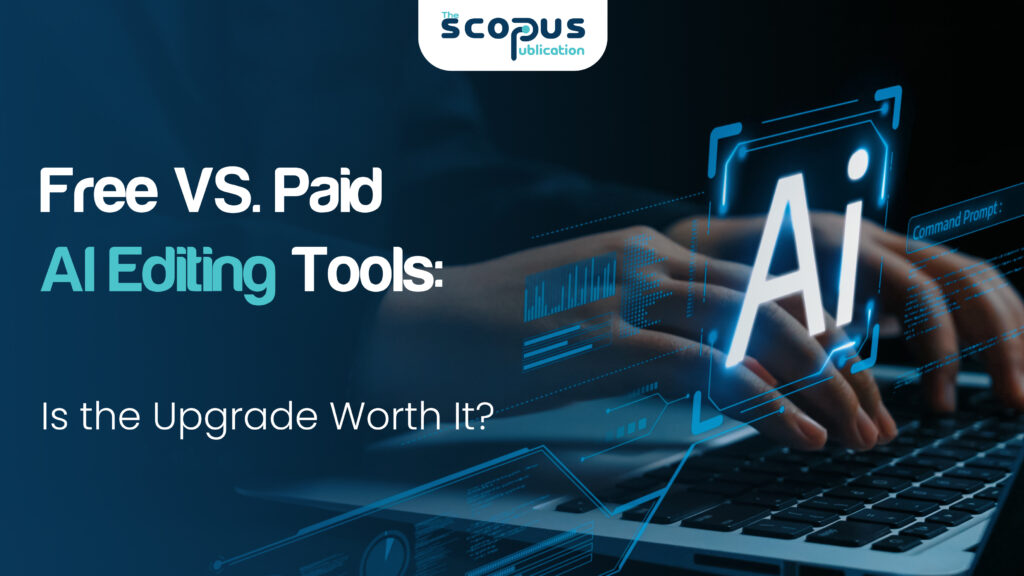In the world of digital writing AI editing tools have become a go-to solution for the writers, students and professionals alike. If you are working on a blog post, an academic thesis or even editing scientific papers, AI driven platforms can help clean up grammar, fix sentence flow and also improve the clarity.
But here is the big question: Should you stick with the free versions or is it worth investing in a paid plan?
Let us explore both sides and by the end you will have a clearer idea of what works best for your needs.
What Are AI Editing Tools?
AI editing tools use the artificial intelligence to help improve your writing. They first scan your content for grammar mistakes, spelling errors, awkward phrasing and even tone or readability.
Some of the most popular tools include the Grammarly, ProWritingAid, Hemingway and Quillbot.
While free versions offer basic spelling and grammar checks, paid ones promise advanced features like tone detection, style suggestions and specialised support for professional writing editing.
What Do Free AI Editors Offer?
Basic Help for Everyday Writers
If you are someone who only needs a quick grammar fix then free tools can do a solid job. Most of them offer essential grammar and spelling checks along with limited clarity suggestions and simple readability analysis. They are often easy to access through browser extensions or web apps.
Let us say you are writing a casual blog or an email. A free tool is often enough to catch small errors and help you look polished. It is user friendly and does not ask for credit card info which is always a plus.
But as someone who’s used these tools regularly, I can say there are times when they fall short. Especially when your content becomes more advanced, say, PhD proofreading or editing scientific papers.
Where Paid AI Editors Shine
Advanced Features That Make a Difference
Paid versions take things up a notch. They offer features like advanced grammar and style suggestions, vocabulary enhancement, tone and intent detection and even genre specific editing options. For tasks like professional writing editing these features bring noticeable improvement.
When I upgraded to Grammarly Premium for a client’s whitepaper I saw immediate benefits. My content sounded more polished, with smoother transitions and more precise word choices. It even helped maintain a consistent formal tone throughout the piece. For academic work such as editing scientific papers these tools catch inconsistencies and formatting issues that often go unnoticed.
Comparing Free and Paid Editors
What You Get and What You Miss
Free tools are great for surface-level edits but they don’t match the depth that paid tools offer. When your writing goes beyond casual use the advanced suggestions in paid versions become much more valuable.
Paid tools can tailor edits based on your writing goals and audience. That means fewer vague suggestions and more targeted improvements that suit your actual needs. Whether it’s writing a blog, a research proposal or a grant application, the context aware suggestions make a significant difference.
Use Case: Academic and Professional Writing
When Quality Really Matters
Let us say you are a student working on your thesis. In this case you might be dealing with complex arguments, citations and industry specific terms. Free tools might catch grammar issues but they won’t help with academic tone or structure.
A paid AI editor can suggest better phrasing and tone adjustments helping you sound more authoritative. If you are doing PhD proofreading, the stakes are higher. Your work represents years of research. One mistake could lead to major revisions. That’s where paid tools really become essential.
Similarly if you are into professional writing editing, like resumes, articles or client presentations, accuracy and polish matter. A paid AI editor gives you that edge.
Human Touch Still Matters
Why You Still Need Human Eyes
Even with the smartest AI, human editors are not going anywhere. Why? Because AI still struggles with nuance. It doesn’t always get sarcasm, cultural references or emotional tone right.
For instance, I once wrote an article that used humour to explain a technical concept. The AI editor kept suggesting “fixes” that actually ruined the punchlines. That is when I realised you still need a human eye to maintain your voice.
If you are editing scientific papers AI tools can streamline formatting and check consistency but complex interpretations or theory-based writing still need human expertise.
Who Should Stick to Free Tools?
Casual writers who blog for fun or write short pieces will find free tools more than enough. Students in their early academic years can get by with basic grammar checks. And if you don’t write often or are simply looking to save money, sticking to free versions is a sensible choice.
Who Should Consider Upgrading?
Academic writers especially those involved in PhD proofreading, benefit greatly from the precision of paid tools. Content creators such as bloggers and marketers, often need more polish and consistency. Professionals who rely on free from errors reports, emails or proposals will also find value. And researchers working on editing scientific papers will appreciate the detailed feedback paid tools provide.
How Much Do Paid Tools Cost?
Common Price Ranges
As of 2025 here are the typical price points. Grammarly Premium costs around $12 per month when billed annually. ProWritingAid is about $10 monthly or offers a lifetime plan. Hemingway Editor has a one time desktop purchase. Quillbot Premium is available for about $8 per month. Many of these tools offer trial periods letting you explore features before making a commitment.
My Personal Experience
Why I Made the Switch
I used free tools for a long time. They helped catch typos and improved my readability. But when I started freelancing and took on professional writing editing projects I realised I needed more.
The switch to a paid plan changed my workflow. My writing became sharper and more consistent. For academic work especially PhD proofreading, the tool’s academic tone suggestions saved time and effort. My clients noticed the quality improvement. And while I still do a final read-through myself the AI tool ensures I miss fewer issues.
Final Thoughts: Is Paid AI Editing Worth It?
If writing is an essential part of your work or study, paid AI editing tools are worth the investment. They speed up editing also improve the tone and structure and offer the peace of mind. They are especially helpful for PhD proofreading, professional writing editing and editing scientific papers.
If you write casually or on a limited budget then free tools still offer great value. They provide a strong safety net for basic errors and are easy to use.
Ultimately AI editing tools are best used as assistants. They improve your writing but your voice, judgment and final read-through remain irreplaceable.


